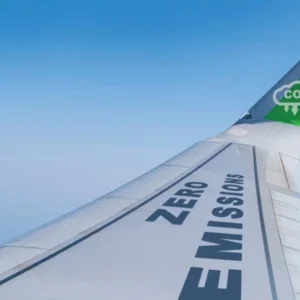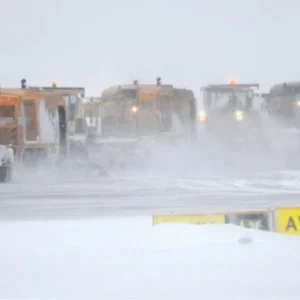
Is it a bird? Is it a plane? In this case, it’s actually a bit of both. Since 2017, the local wildlife around Edmonton International Airport (EIA) have kept an eye out for a new kind of threat, scanning the skies for shadow patrolling above them.
It looks just like a peregrine falcon, but this one is far easier for EIA’s operators to control. Its flight behaviour mimics that of an actual bird, making it indistinguishable from its natural counterpart to such an extent that other birds see it as a predator, and go to great lengths to avoid it. However, instead of feathers, flesh and bone, this bird is made of paint, metal and wire.
“It’s a drone, but it’s also a falcon replica that flaps its wings like a bird,” explains Myron Keehn, vice-president of air service and business development at Edmonton International Airport (EIA), who first saw the Robird at an air show in Tokyo in 2016. “We started using [the Robird] to do wildlife control to help scale and test it – [before that] we had a real, live falcon at the airport.”
EIA use the Robird to herd flocks of birds away and discourage their return, helping to keep the airport’s airspace clear. While individual birds rarely present much threat to an aircraft, a flock of them can bend or break engine blades. In January 2009, a flock of Canada geese famously disabled both engines of a US Airways jet, resulting in an emergency landing on the Hudson river. According to the Federal Aviation Administration (FAA), US civil aircraft suffered 142,000 bird strikes between 1990 and 2013.
This is just one of the myriad ways in which drones are being integrated into airport operations across the world. The Robird was EIA’s first foray into drones, but the airport has since expanded further. From an operations perspective, it uses drones for quantity surveying, using sensors to geomap construction sites. Regarding infrastructure, EIA uses drones to fly over ditches and check for signs of erosion. They’re also used to carry out runway scans to ensure pavement markings are to international standards. EIA’s air fuel team even use drones to look inside their big airfield equipment, such as their runway sweepers or snow clearers.
And that’s only a drop in a bucket that can include aircraft and building inspection, counter-drone operations for keeping public drones out of the airspace, cargo delivery and much more. One particular application that is developing considerable attention in the aviation industry is the use of passenger drones, better known as electric vertical take-off and landing (eVTOL) aircraft. The first eVTOL test centre in Europe was opened in Paris, France, in November 2021, with the hope of having the technology in place for the 2024 Olympics. While there is still considerable work to go, interest in eVTOLs is strong in the industry, with some estimations believing the market for electric air taxis could be worth $500bn in the US alone.
Build-up confidence
However, while EIA has taken strides forward to embrace the technology, many airports are far more hesitant, due in part to its relative nascency – even Edmonton’s relationship with drones only goes back five or six years, after all. The potential that drones present is not debated, but instead, airport operators have been put off by the challenges around getting drones to work safely within their airspaces.
“You don’t have to convince them of the value of drones – that’s not the struggle – but it’s being able to make use of it,” explains Paul Diestelkamp, head of business development and solutions at Air Navigation Solutions, which works with airports and other industry stakeholders across the UK to provide air traffic management services and innovation. “What is lacking is a structured, scalable integration of drones in airports – and beyond.”
That’s not to say that any wariness that airports might have regarding allowing drones and aircraft to operate alongside each other in the same airspace is misplaced, however. Drones pose an even greater threat to aircraft than birds do. It’s for that reason that the Robird, for example, is controlled by a pilot and an observer on the ground, and both are in contact with air traffic control. The Robird is also programmed to stay within a confined area and to keep away from runways. If it were to malfunction, it would fall straight down, avoiding the drift that could send it into danger.
While there have only been a few confirmed cases of a drone colliding with an aircraft mid-air, the threat that drones present is a very real one. It was for that reason, on 19 December 2018, that all air traffic was grounded at Gatwick Airport, due to a potential sighting of two drones within its airspace. Diestelkamp is intimately familiar with the incident, having been at Gatwick on the day, serving as the air navigation services provider.
After the Gatwick incident, many airport operators began taking a much more negative perspective on drones, fearing the same kind of disruption. “[After Gatwick] I saw a strong shift towards seeing drones as problems and pushing them away,” Diestelkamp says, but notes that attitudes towards the technology have begun to recover. “If you look at the industry now, [airports] are starting to see the potential again.”
Communicate to integrate
The first and greatest challenge for drone integration is being able to safely use drones alongside normal airport operations. “I think a lot of so-called ‘integration’ in airports in the past has been physically flying on an airport – but that’s it,” Diestelkamp says. “And the only way that was achieved is by not using that part [of the airport] for aircraft or even blocking it off.”
With that in mind, work needs to be done, then, to drive the assessment, assurance, approval and acceptance aspects of drone integration – testing in rigidly controlled environments away from an active airspace will only go so far. “This isn’t fundamentally solving the problem of integration, which isn’t a technology problem as much as it is a communication problem,” says Diestelkamp. “The key is the translation between the different stakeholders.”
He sees true drone integration in airports as consisting of three separate layers. The first covers implementing data and sensors on-site to collect information. The second layer involves information processing and display – such as how air traffic controllers are able to track drones within an airspace. Diestelkamp and his team see particular importance that, for this layer, such information is displayed on the same tools controllers are currently using. Proper drone integration shouldn’t involve the addition of a new screen for the controller to keep track of, but should instead be visible and trackable in an integrated manner, ideally on the tools they already have at hand.
The final, and most important, layer, however, is the procedural one. “Ultimately, the drone is yet another aircraft, and yet another airspace and airport user,” Diestelkamp says. “No different than any other aircraft, really, in terms of how its managed and how you approach [and] approve it.” Therefore, measures and procedures need to be put in place to enable ATM officials and airspace users to know how to monitor and respond to drones, just as they do for other aircraft. Part of the issue has been that drones are a relatively new technology – or at least, cheap, easily accessible ones are – and the regulations and legislation around them has lagged behind.
142k
Bird strikes on US civil aircraft between 1990 and 2013.
FAA
$45.5bn
Estimated value of the global drone transportation and logistics market by 2027, rising from $12bn in 2020.
Business Wire
While this presents challenges for the various stakeholders involved around airport airspace, it offers far more obstacles when looking to allow drones to operate beyond an airport’s perimeter, or in the case of cargo delivery, for example, to allow for drones to seamlessly enter and exit an airspace. Such ‘beyond visual line of sight’ operations create a slew of new issues for operators to overcome.
“When it comes to the beyond visual line of sight integration, I think there needs to be way more flexibility than ATC offers today,” says Diestelkamp. “Air traffic today is just as rigid as it gets – for good reasons, but it’s very conservative.” It’s also, he would argue, behind modern technology in many ways. And that poses a problem for drone integration, particularly for international airports, when you implement a standard for integration that you can’t achieve in isolation. Airlines and pilots from different regions will ultimately need to be acting off the same playbook when dealing with drones, and for that, a more flexible and dynamic form of air traffic management will be required.
Canada’s gateway to the north
This was one of the challenges faced by EIA, after it signed an agreement with Drone Delivery Canada (DDC) and Air Canada back in October 2019 to develop the world’s first airport-based drone delivery centre. Flashforward to 3 December 2021, when a Sparrow drone from DDC flew from the EIA Airport Operations Facility to a site in Leduc County – Canada’s first drone airport-based delivery operation. Drones will soon be carrying commercial cargo packages from EIA on behalf of clients Ziing Final Mile and Apple Express.
Airspace around all Canadian airports is highly restricted, and so EIA and DDC spent months working with NAV CANADA, which operates Canada’s civil air navigation system, to create new approvals and safety procedures to make drone flights possible. Its first drone trial took place in a landfill 7km from the airport, and used geofencing to ensure that drones on the site could only operate within set GPS coordinates. EIA and its partners then spent months testing those boundaries, before moving to a testing site closer to the airport.
From there, EIA began on-site testing, on the ground side of the airport, away from any aircraft, and progressed from there until ultimately it has been able to run drone operations within 150m of an active runway. In order to maintain safety, the same geofencing protocols are in place to make sure a drone doesn’t stray off path. Every drone is also controlled by a pilot and a co-pilot, and monitored by a NAV CANADA control tower. “They follow a flight plan like everything else,” says Keehn. “It’s extremely regulated, extremely controlled, but still able to operate. Safety is our top priority as an airport.”
The DDC cargo drones follow a pre-programmed flight path, and are observed by a control centre in Toronto that can take control of the drone remotely if needed. When with EIA airspace, two pilots will be on ground to take control, just as with other drone operations on-site.
Ultimately, all of EIA’s advances with drones are due to the solid foundation it’s built through partnerships with other organisations in the Canadian aviation industry. Keehn attributes this to the culture of innovation in EIA and Edmonton as a region, and the work Edmonton does through its Sustainability Campus, which is where the DDC cargo drones first originated as an idea. “When you start to allow people to explore new paradigms, you attract innovation, right?” he says. “Innovation begets innovation.”
From there, EIA’s work with partners like the federal and provincial governments, and the various companies mentioned previously, along with Transport Canada, Alberta Transportation and Aerium Analytics, have been key in its drone integration process. The challenges facing airport operators who wish to implement drones are numerous, and to overcome them, Diestelkamp believes that the “biggest thing is getting everyone to talk the same language”, to which Keehn agrees wholeheartedly.
When that works, however, as EIA has demonstrated, the potential that drones offer for airports is hard to dispute. All that remains, now, is for the rest of the world to catch up. And with the pace of development for drone technology, that’s likely to be sooner rather than later. “I mean, it’s going to sound cheeky, but the sky’s the limit for drones. […] It’s just it’s amazing how it’s evolving, and how quickly,” says Keehn. “It’s exhilarating to see this happening on our watch – while we’re here to actually be able to participate, and it’s just an exciting place to be.”






